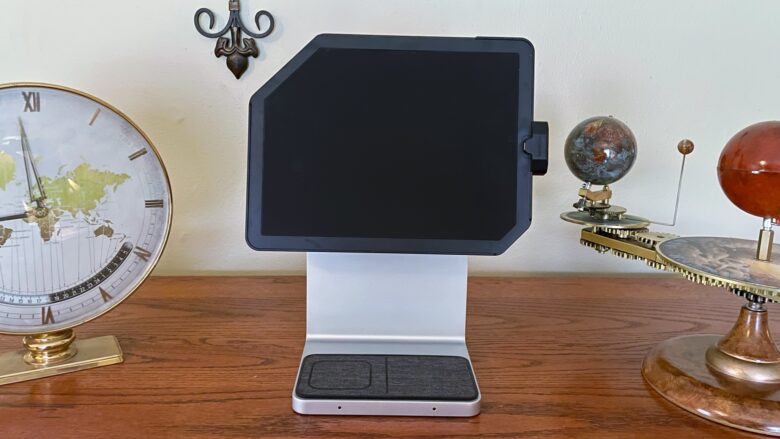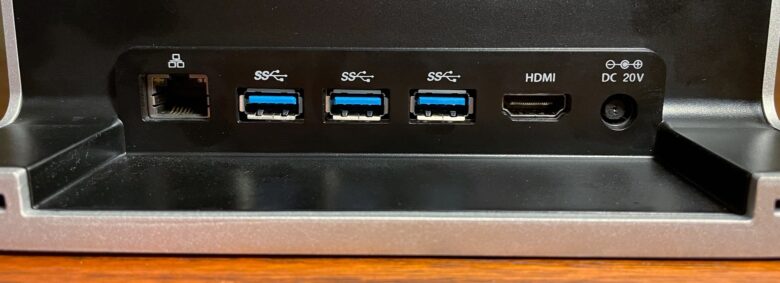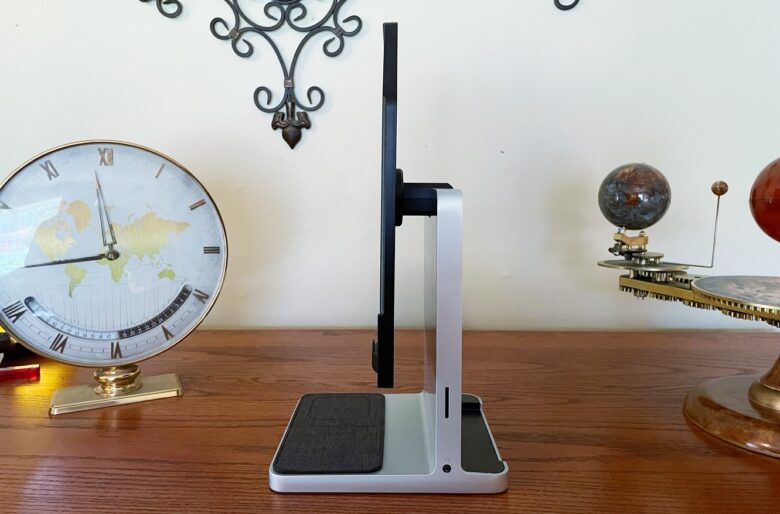Imagine an iMac with an iPad for its screen and you’ve got the Kensington StudioDock. Slip your tablet into the docking station and it’s elevated to eye level, plus you have access to an extensive collection of built-in ports. The stand can even wirelessly charge your other Apple devices.
Read on to explore all the reasons why this is the best iPad desktop stand ever made.
Kensington StudioDock iPad Docking Station review
My iPad Pro is my primary computer. It does everything I need, and is much more flexible than a MacBook. During the workday, I keep the tablet in a stand, and I’ve never found a better option than the StudioDock.
It works well doing its basic job, very securely holding an iPad up where I can see it. And switching between landscape and portrait is easy. But that’s only the start.
I can plug in a wide array of accessories and leave them attached. That includes external drives, keyboard and mouse. And a second monitor and speakers, too.
The StudioDock can also juice up an iPhone and AirPods. And there’s an optional Apple Watch charger.
Really, it turns your iPad into a full-featured desktop. It even has features not in the iMac. And you can always unclip the tablet and use it on the go, something no iMac can offer.

Photo: Ed Hardy/Cult of Mac
Hardware and design
The Kensington StudioDock looks a bit like an iMac with the screen removed. It has a hefty base and isn’t going to be knocked over by anything less than a natural disaster. But this is a big accessory that demands a chunk of your desktop. I have the version for the 12.9-inch iPad Pro, and it’s 11.3 inches wide, 13.8 inches tall, and 7.7 inches deep.
The design is reminiscent of the base of the Pro Display XDR — surely not a coincidence. The silver with black color scheme matches other Apple gear very well.
The tablet attaches magnetically to a flat plate available in various sizes depending on your tablet. There’s a model for the 12.9-inch iPad Pro and another for the 11-inch iPad Pro and 2020 iPad Air. The connection is secure, but the computer is also easily removable.
Once attached, a very wide range of viewing angles is available. But there’s also a limitation. My iPad is held with the bottom edge about 7.5 inches off the top of the desk in landscape mode, depending on the viewing angle. But StudioDock offers no other height adjustment. Of course, that’s true for an iMac too.
Switching between landscape and portrait orientations is as easy as grabbing and rotating the computer.
A power button on the left side of the stand lets you shut down all the ports and chargers when you’re away from your desk. Or leave them on to power up your Apple devices.
All of these features take a lot of electricity. There’s a hefty power brick required, but that’s no problem because studioDock is in no way portable. It stays on your desk while you take your iPad to meetings, a coffee shop, wherever.
Ports

Photo: Ed Hardy/Cult of Mac
The tablet connects to Kensington’s iPad docking station via its USB-C port for power. It offers 37.5 watts, which is plenty for fast charging.
Thanks to the USB-C port, Apple’s high-end tablets can use a broad array of ports, and the StudioDock offers just about all of them. None of them require additional software: it’s plug and play.
On the back are three USB-A ports that support USB 3.1 Gen 1, which means data transfers at up to up to 5Gbps. Use these to connect to the myriad of USB accessories in widespread use that don’t use USB-C. For me, that’s a mouse and a thumb drive. Both worked exactly as expected, with the cursor appearing automatically and the removable drive showing up in the Files app. Or the USB-A ports can charge other devices. They provide 5V/3A or 9V/2.22A.
On the left side of the StudioDock is a USB-C port. This also supports USB 3.1 Gen 1, which means it can’t be used with an external monitor. But it’s great for other accessories: I tested the Samsung T7 SSD without a hitch.
Not missing a trick, you can slide an SD card into right edge of this stand. It supports UHS-II and SD4.0 for speedy transfers. You’ll need an adapter to use microSD cards, but those generally come bundled with the tiny memory cards.
Also on the back of Kensington’s iPad docking station is a 4K HDMI 2.0 video port. Here’s where you plug in that second monitor I mentioned before. The port can handle up to a 3840 by 2160 screen at a full 60Hz. iPads currently offer somewhat limited support for external monitors, but there are benefits nevertheless. And we can hope Apple will make support more robust.
If Wi-Fi in your office is shaky or too insecure there’s a Gigabit Ethernet port on the back of the iPad stand, too.
Plug external speakers into the 3.5mm audio jack on the right edge and you’re ready for high-quality music while you work. It’s also a microphone port, so you can plug in a headset for FaceTime calls.
Don’t overlook the convenience of being able to leave these accessories permanently attached to the StudioDock. You can easily remove and later reconnect your iPad, and your keyboard, hard drive, whatever are there waiting for you.
Incidentally, the accessory does not block access to the Apple Pencil charging port on the edge of the iPad.
Wireless charging
A feature that help puts the Kensington StudioDock over the top is the two wireless chargers built into the base. Place an iPhone or two on these and they’ll start receiving 7.5 watts.
The left charging pad has a handy guide for centering your AirPods or AirPods Pro charging case. But don’t be confused — my tests showed this pad powers up an iPhone too.
An optional Apple Watch charger is planned for later in 2021. Kensington included one with my review unit. This clips to the side of the StudioDock, next to the iPad, which converts the wearable into a clock that’s always available.

Photo: Ed Hardy/Cult of Mac
Kensington StudioDock iPad Docking Station final thoughts
StudioDock is the full-featured iPad stand some of us have been hoping for. It’s far more than a solid way to hold up your tablet thanks to its many ports for connecting to accessories. It makes an iPad into a small iMac… an iMac that lets you pop off the screen and take it with you. And the built-in wireless chargers are icing on the cake.
I try to be judicious in my reviews, but it was very hard this time. I love this iPad docking station. Love it.
Pricing
Kensington markets StudioDock for creative professionals, not casual users. And its priced to match.
There are two versions: one designed for the 11-inch iPad Pro and 2020 iPad Air is $379.99. The version for the 12.9-inch iPad Pro is $399.99. Either can be ordered from Kensington’s website.
Comparable products
I’m not aware of a direct competitor for this product. The closest I can get is a combination. You can, for example, put your iPad in the Satechi Aluminum Desktop Stand ($44.99) and attach the HyperDrive Power 9-in-1 USB-C Hub ($79.99). Or there are plenty of other tablets stands and USB-C multiport adapters available. And you’ll have to add a dual-mat wireless charger, like the Choetech Dual Wireless Fast Charger ($35.99).
Use them in combination and you’ll pay less, but the StudioDock has the advantage of being an integrated product. That’s a real benefit in convenience.
Kensington provided Cult of Mac with a review unit for this article. See our reviews policy, and check out other in-depth reviews of Apple-related items.
![StudioDock brilliantly transforms iPad into iMac mini [Review] Kensington StudioDock iPad Docking Station review](https://www.cultofmac.com/wp-content/uploads/2021/03/45475206-66D9-4340-851F-450ADB87ADEF-1536x950.jpeg)

